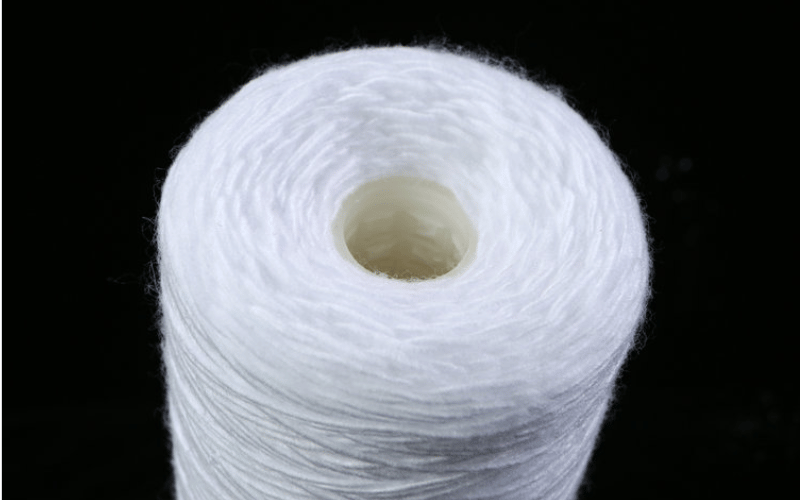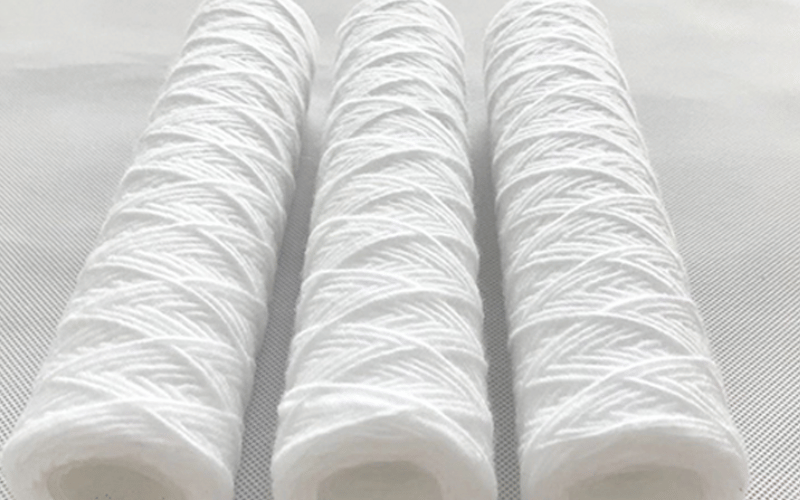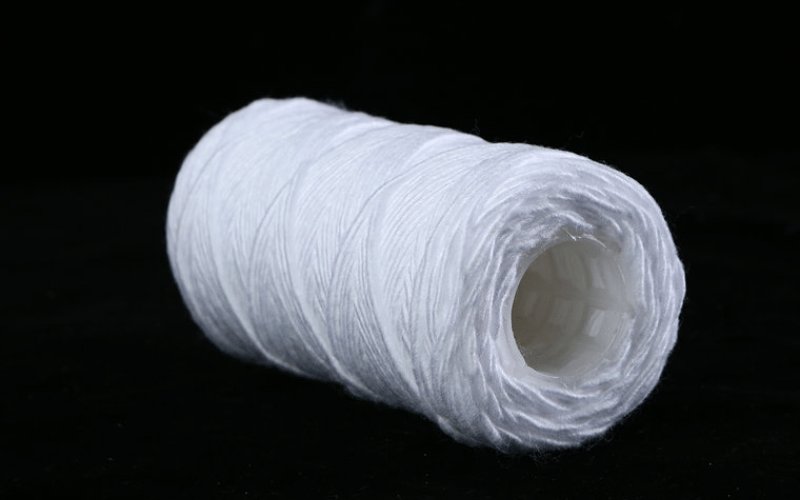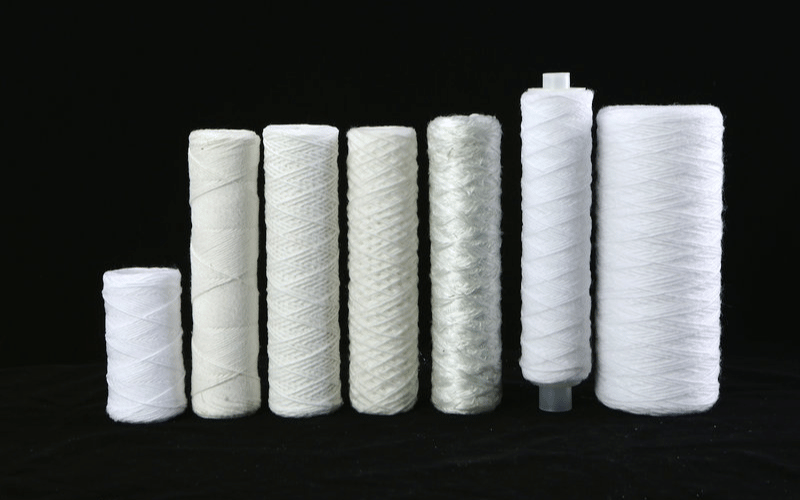String-wound filter cartridges are precision-engineered filtration devices designed to remove particulate contaminants from liquids with exceptional efficiency. Constructed from tightly wound textile yarns around a perforated core, these filters excel in depth filtration, trapping particles throughout their entire structure rather than just on the surface.
In today’s world, adequate filtration is critical across countless applications, from ensuring safe drinking water in homes to maintaining sterile conditions in pharmaceutical manufacturing. Industries rely on filtration to protect equipment, improve product quality, and meet stringent regulatory standards. Among the various filtration solutions available, string wound cartridges stand out for their versatility, cost-effectiveness, and reliable performance—making them the go-to choice for applications ranging from municipal water treatment to food processing and chemical manufacturing.
But what exactly makes string-wound filters so widely adopted? How do they compare to other filtration technologies, and what industries benefit most from their unique design?
Let’s explore the engineering behind string-wound filter cartridges, their key advantages, and the diverse applications where they deliver unmatched performance.
Table of Contents
ToggleUnderstanding String Wound Filter Cartridges
What is a String Wound Filter Cartridge?
A string-wound filter cartridge is a cylindrical filtration device made by tightly winding a continuous strand of material (such as cotton, polypropylene, or fiberglass) around a central core. This design creates a gradient structure, with tighter winding near the core and looser winding on the outer layers, allowing it to effectively capture particles of varying sizes. These cartridges are commonly used in industries like water treatment, food and beverage production, pharmaceuticals, and chemical processing to remove impurities and ensure the purity and quality of liquids.
How Are String-Wound Filter Cartridges Constructed?
The construction of a string-wound filter cartridge involves winding yarn or threads tightly around a central core. The core, typically made of materials like stainless steel or polypropylene, serves as the backbone of the cartridge, providing structural integrity. The yarn or threads are wound in a precise pattern to create a gradient density structure. This design allows the cartridge to capture particles of varying sizes, with larger particles being trapped on the outer layers and finer particles being filtered as the liquid moves inward.
Key Features of String Wound Filter Cartridges
- Gradient Density: The unique winding pattern creates a gradient density that enhances filtration efficiency. This feature ensures that the cartridge can handle a wide range of particle sizes, extending its lifespan and reducing the frequency of replacements.
- Customizable Micron Ratings: String wound filter cartridges are available in various micron ratings, allowing users to select the level of filtration that best suits their specific application. Micron ratings typically range from 1 to 100 microns, catering to both fine and coarse filtration needs.
- Material Options: These cartridges can be manufactured from various materials, including polypropylene, cotton, or glass fiber, depending on the specific application requirements. The choice of material ensures compatibility with different liquids, including water, chemicals, and oils, making them versatile and adaptable to diverse industrial processes.
By understanding the construction and features of string-wound filter cartridges, businesses can make informed decisions about their filtration needs, ensuring optimal performance and cost-effectiveness.
How String-Wound Filter Cartridges Function
The Depth Filtration Process Explained
String-wound filter cartridges operate using a depth filtration mechanism, which is designed to trap contaminants throughout the entire thickness of the filter material. Unlike surface filtration, which captures particles only on the outer layer, depth filtration allows the liquid to pass through multiple layers of tightly wound threads. As the fluid flows inward, particles are progressively trapped within the cartridge, ensuring thorough and efficient filtration. This multi-layered approach enhances the cartridge’s capacity to hold dirt and extends its operational life.
The Role of Gradient Density in Capturing Particles
A key feature of string-wound filter cartridges is their gradient density structure. This design involves winding the threads in a way that creates varying levels of density across the cartridge. The outer layers are less dense, allowing them to capture larger particles, while the inner layers are more tightly packed to filter out finer contaminants. This gradual filtration process ensures that the cartridge can handle a wide range of particle sizes, improving its overall efficiency and reducing the risk of clogging.

Comparing Depth Filtration to Surface Filtration
When compared to surface filtration methods, string-wound filter cartridges offer several advantages. Surface filters rely on a single layer to trap particles, which can lead to faster clogging and reduced efficiency over time. In contrast, the depth filtration process of string wound cartridges provides a higher dirt-holding capacity, making them more suitable for applications with high levels of contaminants. Additionally, the gradient density structure ensures a more consistent filtration performance, even under varying flow rates and pressure conditions.
By leveraging the depth filtration process and gradient density design, string-wound filter cartridges deliver reliable and efficient filtration, making them a preferred choice for industries requiring high-performance liquid filtration solutions.
Key Features and Advantages of String Wound Filter Cartridges
Gradient Density Filtration for Comprehensive Particle Removal
One of the standout features of string-wound filter cartridges is their gradient density design. This innovative structure ensures that both large and small particles are effectively captured as the liquid flows through the cartridge. The outer layers, being less dense, trap larger contaminants, while the inner, tightly packed layers filter out finer particles. This layered approach not only enhances filtration efficiency but also ensures a more thorough purification process, making these cartridges ideal for applications requiring high levels of cleanliness.
High Dirt-Holding Capacity for Extended Use
String-wound filter cartridges are designed to hold a significant amount of dirt and debris, thanks to their depth filtration mechanism. This high dirt-holding capacity reduces the need for frequent replacements, saving both time and operational costs. By capturing contaminants throughout the entire cartridge thickness, these filters maintain consistent performance over extended periods, even in environments with high levels of impurities.
Durability to Handle Challenging Conditions
Built to withstand high pressures and variable flow rates, string-wound filter cartridges are known for their durability. The robust construction ensures that the cartridges remain intact and functional even under demanding conditions, such as those found in industrial processes or high-pressure systems. This resilience makes them a reliable choice for applications where consistent performance is critical.
Customizable Micron Ratings for Versatile Filtration
To cater to a wide range of filtration needs, string-wound filter cartridges are available in various micron ratings, typically ranging from 1 to 100 microns. This flexibility allows users to select the appropriate level of filtration for their specific application, whether it involves removing fine particles or larger debris. The ability to customize the filtration level ensures optimal performance and adaptability across different industries.
Material Versatility for Diverse Applications
String-wound filter cartridges are available in a variety of materials, including polypropylene, cotton, and glass fiber. Each material offers unique properties, making the cartridges suitable for different applications. For instance, polypropylene is ideal for chemical compatibility, cotton is preferred for food-grade applications, and glass fiber excels in high-temperature environments. This material versatility ensures that the cartridges can meet the specific requirements of various industries, from water treatment to pharmaceuticals.
By combining these key features, string-wound filter cartridges provide a reliable, efficient, and versatile solution for liquid filtration, making them a preferred choice across a wide range of applications.
Applications of String Wound Filter Cartridges Across Industries
Water Treatment: Effective Removal of Impurities
String-wound filter cartridges play a crucial role in water treatment systems, both in residential and industrial settings. They are highly effective in removing sediment, rust, dirt, and other particulate matter from water, ensuring its clarity and quality. These cartridges are commonly used in pre-filtration stages to protect downstream equipment and improve the efficiency of more advanced filtration systems. Their ability to handle varying flow rates and pressures makes them a reliable choice for a wide range of water treatment applications.
Food and Beverage Industry: Purifying Liquids for Quality Assurance
In the food and beverage sector, maintaining the purity and safety of liquids is paramount. String-wound filter cartridges are widely used to filter liquids such as syrups, juices, and water, ensuring they meet stringent quality standards. Their customizable micron ratings allow for precise filtration, removing unwanted particles without compromising the flavor or consistency of the product. Additionally, the availability of food-grade materials, such as cotton, makes these cartridges suitable for applications requiring compliance with health and safety regulations.
Chemical Processing: Handling Aggressive Substances
The chemical processing industry frequently encounters aggressive chemicals and solvents that necessitate robust filtration solutions. String-wound filter cartridges, particularly those made from materials like polypropylene, are designed to withstand harsh chemical environments. They effectively remove contaminants from liquids, ensuring the integrity of the chemical processes and protecting sensitive equipment from damage. Their durability and chemical compatibility make them an essential component in various chemical processing applications.
Pharmaceuticals: Ensuring Sterility and Purity
In the pharmaceutical industry, maintaining sterility and purity during liquid filtration is critical. String-wound filter cartridges are used to remove particulates and impurities from liquids, ensuring they meet the rigorous standards required for pharmaceutical production. Their gradient density design and customizable micron ratings allow for precise filtration, making them suitable for applications such as the preparation of injectable solutions, sterile water, and other pharmaceutical products.
Oil and Gas Industry: Filtration of Fuels and Fluids
String-wound filter cartridges are also widely used in the oil and gas industry for filtering fuels, lubricants, and hydraulic fluids. These cartridges help remove contaminants such as dirt, rust, and debris, ensuring the smooth operation of machinery and equipment. Their high dirt-holding capacity and ability to withstand high pressures make them ideal for demanding applications in this industry, where reliability and efficiency are paramount.
By serving a wide range of industries, string wound filter cartridges demonstrate their versatility and effectiveness in addressing diverse filtration needs, from ensuring water quality to supporting critical industrial processes.
How to Select the Ideal String Wound Filter Cartridge
Key Factors to Consider When Choosing a Filter Cartridge
Selecting the right string-wound filter cartridge is essential to ensure optimal filtration performance and longevity. Here are the critical factors to evaluate:
Micron Rating: Matching Filtration Precision to Your Needs
The micron rating of a filter cartridge determines the size of particles it can capture. Lower micron ratings, such as 1 or 5 microns, are ideal for fine filtration, removing smaller contaminants. Higher ratings, like 50 or 100 microns, are better suited for coarse filtration, targeting larger particles. Assess the specific filtration requirements of your application to choose a cartridge with the appropriate micron rating.
Material Compatibility: Ensuring Chemical and Fluid Suitability
The material of the filter cartridge must be compatible with the fluid being filtered to prevent degradation or contamination. For instance, polypropylene is resistant to a wide range of chemicals, making it suitable for industrial and chemical applications. Cotton is often used in food-grade processes, while glass fiber is ideal for high-temperature environments. Understanding the chemical properties of the fluid will help you select a material that ensures durability and safety.
Temperature and Pressure Requirements: Evaluating Operating Conditions
String-wound filter cartridges are designed to withstand varying levels of temperature and pressure. It is crucial to choose a cartridge that can handle the specific operating conditions of your system. For high-pressure or high-temperature applications, opt for cartridges made from robust materials, such as stainless steel cores or glass fiber. This ensures consistent performance and prevents cartridge failure under extreme conditions.
Contaminant Load and Flow Rate: Balancing Efficiency and Longevity
The level of contaminants in the fluid and the required flow rate are important considerations. High contaminant loads may require cartridges with a higher dirt-holding capacity to reduce the frequency of replacements. Similarly, the flow rate should align with the cartridge’s design to maintain efficient filtration without compromising performance. Evaluate these factors to select a cartridge that strikes a balance between efficiency and operational longevity.
Tips for Selecting the Right Cartridge for Specific Applications
- Understand Your Application Needs: Clearly define the purpose of filtration, whether it’s for water treatment, chemical processing, or food and beverage production. This will guide your choice of micron rating, material, and other specifications.
- Consult Manufacturer Guidelines: Refer to the manufacturer’s recommendations for compatibility and performance to ensure the cartridge meets your system’s requirements.
- Test Before Full Implementation: Conduct a trial run with the selected cartridge to verify its performance under actual operating conditions. This helps identify any potential issues before they become a problem during full-scale use.
- Consider Long-Term Costs: While initial costs are essential, also factor in the cartridge’s lifespan, replacement frequency, and maintenance requirements to determine overall cost-effectiveness.
By carefully evaluating these factors and following these tips, you can select the most suitable string-wound filter cartridge for your specific application, ensuring efficient and reliable filtration.
Maintenance and Replacement of String-Wound Filter Cartridges
Recognizing When to Replace a Filter Cartridge
Timely replacement of string-wound filter cartridges is essential to maintain optimal filtration performance. Here are some common signs that indicate a cartridge needs to be replaced:
- Reduced Flow Rate: A noticeable decrease in the flow of liquid through the system often signals that the cartridge is clogged with contaminants.
- Pressure Drop: A significant drop in pressure across the filter indicates that the cartridge is reaching its dirt-holding capacity and is no longer functioning efficiently.
- Visible Contamination: In some cases, visible dirt or discoloration on the cartridge may suggest it has reached the end of its service life.
Monitoring these indicators helps prevent system inefficiencies and ensures consistent filtration quality.
Recommended Replacement Intervals
The frequency of cartridge replacement depends on factors such as usage, sediment load, and the specific application. As a general guideline:
- For systems with high contaminant loads, cartridges may need to be replaced every few weeks.
- In applications with lighter sediment loads, cartridges can last several months.
- Regularly inspect the cartridge and follow the manufacturer’s recommendations for replacement intervals to avoid overuse or premature changes.
Establishing a maintenance schedule tailored to your system’s needs ensures uninterrupted performance and optimal cost efficiency.
Proper Cleaning and Storage of Filter Housings
Maintaining the filter housing is just as important as replacing the cartridge. Follow these steps for proper cleaning and storage:
- Cleaning the Housing: After removing the used cartridge, thoroughly clean the housing with a mild detergent or cleaning solution to remove any residual sediment or debris. Rinse it well to ensure no cleaning agents remain.
- Inspecting for Damage: Check the housing for cracks, leaks, or wear that could compromise its performance. Replace damaged components as needed.
- Drying and Storing: Allow the housing to dry entirely before reassembling or storing it. Store the housing in a clean, dry environment to prevent contamination or damage.
Regular maintenance of the housing extends its lifespan and ensures the effectiveness of the filtration system.
Disposal and Recycling of Used Cartridges
Proper disposal of used filter cartridges is crucial for environmental sustainability. Here are some best practices:
- Disposal: If the cartridge has been used to filter non-hazardous liquids, it can typically be disposed of in the regular waste stream. For cartridges exposed to hazardous chemicals, follow local regulations for safe disposal.
- Recycling: Some cartridges, especially those made from recyclable materials like polypropylene, can be recycled. Check with local recycling facilities or the cartridge manufacturer for recycling options.
- Minimizing Waste: Consider using cartridges with a longer lifespan or those specifically designed for a particular application to reduce waste and minimize environmental impact.
By adhering to these maintenance and replacement practices, you can ensure the longevity and efficiency of your filtration system while minimizing environmental impact.
Innovations in String Wound Filter Technology
Advancements in Materials and Manufacturing
Recent developments in string-wound filter technology have focused on improving materials and manufacturing processes to enhance performance and durability. Modern cartridges now utilize advanced materials, including high-performance polymers and specialized fibers, that offer superior chemical resistance, temperature tolerance, and structural integrity. These materials ensure compatibility with a broader range of applications, including those involving aggressive chemicals or extreme operating conditions. Additionally, automated manufacturing techniques have enhanced the precision of the winding process, leading to more consistent quality and improved filtration performance.
Eco-Friendly and Sustainable Options
As industries prioritize sustainability, string-wound filter technology has evolved to include eco-friendly options. Manufacturers are increasingly utilizing biodegradable or recyclable materials, such as natural fibers and recyclable polymers, to minimize their environmental impact. Some cartridges are designed with reusable cores, allowing users to replace only the filter media while retaining the core, thereby minimizing waste. These innovations align with global efforts to promote sustainable practices and reduce the carbon footprint of industrial processes.
Enhanced Filtration Efficiency with Improved Winding Techniques
Innovative winding techniques have significantly improved the filtration efficiency of string-wound cartridges. Advanced gradient density designs now feature more precise layering, enabling better particle capture and a higher dirt-holding capacity. These techniques ensure that the cartridges can handle a broader range of particle sizes while maintaining consistent flow rates and reducing the risk of clogging. Additionally, some manufacturers have introduced multi-layered winding patterns that enhance the depth filtration process, further extending the lifespan of the cartridges and improving overall performance.
By incorporating these innovations, string-wound filter cartridges continue to evolve, offering more efficient, durable, and environmentally friendly solutions for a wide range of filtration needs.
Why Choose Our String Wound Filter Cartridges?
Superior Quality Materials for Reliable Performance
Our string-wound filter cartridges are crafted using premium materials, ensuring exceptional durability and compatibility with a wide range of applications. Whether you require polypropylene for chemical resistance, cotton for food-grade applications, or glass fiber for high-temperature environments, we offer materials specifically tailored to meet your unique requirements. Each cartridge is manufactured with precision to deliver consistent filtration performance, even under demanding conditions.
Competitive Pricing Without Compromising Quality
We understand the importance of cost-effectiveness in industrial operations. That’s why our string-wound filter cartridges are competitively priced, offering excellent value for money. By combining affordability with high-quality construction, we help you achieve efficient filtration without exceeding your budget. Our focus on long-lasting products also reduces the frequency of replacements, further lowering operational costs over time.
Extensive Range of Options for Every Application
Our product line features a diverse range of string-wound filter cartridges, available in various micron ratings, materials, and sizes. This extensive range ensures that you can find the perfect cartridge for your specific filtration needs, whether it’s for water treatment, chemical processing, or pharmaceutical production. Additionally, we offer customizable solutions to address unique challenges, providing you with a truly tailored filtration experience.
Case Studies: Real-World Success Stories
In one case, a chemical processing plant faced frequent filter replacements due to high contaminant loads. After switching to our string-wound filter cartridges with enhanced dirt-holding capacity, the plant reduced replacement frequency by 40%, saving both time and costs. Another client in the pharmaceutical industry achieved consistent sterility in their liquid filtration process, thanks to our precision-engineered cartridges.
By choosing our string-wound filter cartridges, you’re investing in reliable, cost-effective, and high-performance filtration solutions backed by proven results and customer satisfaction.
Frequently Asked Questions
Q: What is a string wound filter cartridge?
A: A string wound filter cartridge is a type of filter made by tightly winding fibers around a central core. This design provides depth filtration, effectively capturing particles and sediments from liquids. It is commonly used in water filtration and other industrial applications.
Q: How does a string wound sediment filter work?
A: A string wound sediment filter works through depth filtration. As water flows through the wound fibers, larger particles and sediment are trapped throughout the cartridge’s layers. This design increases dirt-holding capacity and ensures efficient filtration.
Q: What are the micron ratings for string wound filter cartridges?
A: String wound filter cartridges are available in micron ratings ranging from 0.5 microns to 100 microns. Lower micron ratings capture smaller particles, making them ideal for fine filtration, while higher ratings are better suited for removing larger sediment and impurities.
Q: What are the benefits of using a polypropylene string wound cartridge?
A: Polypropylene string wound cartridges are:
- Durable: Resistant to wear and tear.
- Chemical-Resistant: Suitable for filtering a wide range of fluids, including water, solvents, and mild chemicals.
- Economical: Cost-effective for various applications.
They are ideal for well water, drinking water, and industrial filtration, effectively reducing sediment and improving water quality.
Q: What sizes do string wound filter cartridges come in?
A: String wound filter cartridges are available in standard sizes, such as 10 x 2.5 inches and 10 x 4.5 inches, to fit different filtration systems and housing configurations. Larger sizes are also available for industrial applications.
Q: What is the flow rate of a string wound water filter?
A: The flow rate of a string wound water filter depends on its design and micron rating. Lower micron ratings may reduce flow rates due to finer filtration, while higher micron ratings allow faster flow but may not capture smaller particles as effectively.
Q: Can a string wound filter cartridge remove rust and larger particles?
A: Yes, string wound filter cartridges are highly effective at removing rust, sand, and larger particles from water. Their depth filtration design ensures efficient sediment removal, making them suitable for drinking water, industrial processes, and other applications.
Q: Are string wound sediment filters compatible with reverse osmosis systems?
A: Yes, string wound sediment filters are often used as pre-filters in reverse osmosis (RO) systems. They reduce sediment and protect the RO membrane from larger particles, enhancing the system’s overall efficiency and lifespan.
Q: What is the difference between nominal and absolute filtration ratings?
A:
- Nominal Filtration Rating: Refers to the average particle size the filter can capture (e.g., 90% of particles at a specific size).
- Absolute Filtration Rating: Indicates the maximum particle size the filter can completely remove (e.g., 99.9% of particles at a specific size).
Understanding these ratings helps in selecting the right filter for your specific filtration needs.
The Bottom Line
String-wound filter cartridges have proven indispensable across industries, offering a robust, economical, and highly effective solution for particulate removal. Whether it’s protecting sensitive equipment in manufacturing, ensuring water purity in municipal systems, or maintaining product integrity in food and pharmaceutical production, these filters deliver consistent performance where it matters most.
Their customizable micron ratings, material options, and durable construction make them adaptable to nearly any filtration challenge, from high-flow industrial processes to precision liquid purification.
Ready to optimize your filtration system? Explore our comprehensive range of string-wound filter cartridges—available in various sizes, materials, and micron ratings to meet your specific needs. Contact our filtration experts today to find the perfect solution for your application and experience the difference quality filtration can make.
When reliability and efficiency are non-negotiable, trust string-wound filter cartridges to deliver exceptional results—every time.
Related Posts
- Filtration vs. Reverse Osmosis: A Clear Guide to Choosing the Right Water Purification Method
- Self-Cleaning Filters: Types, How They Work & Automatic Filtration
- Ultimate Guide to Wastewater Treatment Filters: Types, Benefits, and Innovations
- Filtered vs. Distilled vs. Purified Water: Key Differences Explained




